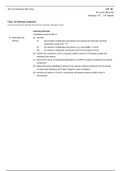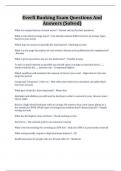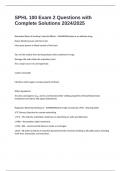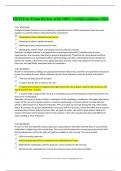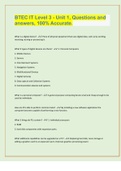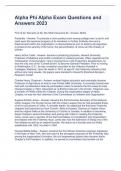Revision Material
Duration: 9th – 14th March
Topic 18 Carbonyl compound
This topic introduces the chemistry of the carbonyl compounds, aldehydes, ketones.
Learning outcomes
Candidates should be able to:
18.1 Aldehydes and (a) describe:
ketones (i) the formation of aldehydes and ketones from primary and secondary alcohols
respectively using Cr2O72- / H+
(ii) the reduction of aldehydes and ketones, e.g. using NaBH4 or LiAlH4
(iii) the reaction of aldehydes and ketones with HCN and NaCN or KCN
(b) describe the mechanism of the nucleophilic addition reactions of hydrogen cyanide with
aldehydes and ketones
(c) describe the use of 2,4-dinitrophenylhydrazine (2,4-DNPH) to detect the presence of carbonyl
compounds
(d) deduce the nature (aldehyde or ketone) of an unknown carbonyl compound from the results
of simple tests (Fehling’s and Tollens’ reagents; ease of oxidation)
(e) describe the reaction of CH3CO– compounds with alkaline aqueous iodine to give tri-
iodomethane
, 18.1 Aldehydes and ketones
(a) Describe:
1. Introduction
Carbonyl group
120℃
Aldehydes and ketones both contain the carbonyl group, C=O.
The position of the carbonyl group in the carbon chain is different in aldehydes and ketones.
The carbonyl group is at the end of the carbon chain in aldehydes and in the middle in ketones. The suffix for aldehydes is
-al and the suffix for ketones is -one.
2. Structures of aldehydes and ketones
Aldehydes Ketones
General molecular formula CnH2nO CnH2nO
Functional group
(-CHO) Alkyl groups
Example CH3CH2CHO CH3COCH3
(functional group isomers) O O
CH3CH2CH CH3CCH3
3. Names of aldehydes and ketones
Aldehyde
HCHO methanal
CH3CHO ethanal
CH3CH2CHO propanal
CH3CH2CH2CHO butanal
Ketone
O propanone
CH3CCH3
4. Physical properties
- Relatively high boiling point / melting point (HCHO is a gas at r.t.p.)
- Soluble in water for the aldehydes or ketones containing small amounts of carbon atoms
These compounds can form hydrogen bonds with water molecules
CH3
H
This ‘H’ does not form hydrogen bonds with water molecules it is boning to a carbon.

